Hostas are a favorite among gardeners, loved for their beautiful leaves and ability to thrive in shady spots. With over 3,000 varieties, they offer endless choices for your garden. This guide will help you identify hostas, learn about their unique features, and care for them with ease.Guide to Identifying Hostas
Introduction to Hostas
Hostas, often called plantain lilies, are low-maintenance plants that bring life to shaded gardens. They are known for their stunning leaves that come in many colors and shapes. While hostas do flower, their gorgeous foliage is the real showstopper. From bright green to deep blue or even variegated patterns, these plants can transform any garden corner into a lush oasis.

Why Are Hostas Popular in Gardens?
Hostas are loved for their ability to create a calming, elegant atmosphere in gardens. Whether you use them as ground covers, along pathways, or in pots, they add texture and beauty to any space. They’re also easy to grow and require little effort, making them perfect for beginners. For experienced gardeners, hostas provide endless design options with their wide variety of sizes and colors.
How to Identify Hostas?
Leaf Shape and Size
Hostas are best identified by their leaves. Some have heart-shaped leaves, while others may be long and narrow. The edges can be smooth or wavy, adding to their charm. Their size ranges from tiny, delicate leaves to large, dramatic ones that make a bold statement.
Leaf Color Variations
Hosta leaves are available in shades of green, blue, and yellow. Many varieties also feature striking variegation, with white, cream, or gold accents. These colors can even change with the seasons, starting bright and bold in spring before softening in summer.
Growth Patterns and Size of Plants
Hostas come in all sizes, from tiny plants under six inches tall to giants over 30 inches. Their growth habits also differ—some spread wide and low, creating a carpet-like effect, while others grow tall and upright for a more structured look.
Flowers of Hostas
While their leaves are the main attraction, hostas also produce delicate flowers. These bell-shaped blooms come in lavender, white, or pink and appear on tall stalks above the foliage, adding extra interest during the blooming season.

Common Types of Hostas
Miniature Hostas
These tiny hostas are ideal for small spaces or container gardens. Varieties like ‘Mouse Ears’ and ‘Tiny Tears’ are perfect for edging pathways or adding charm to patios.
Medium-Sized Hostas
Medium hostas are versatile and work well in most garden layouts. Options like ‘Francee’ and ‘Patriot’ offer balanced beauty, making them great for borders or as standalone features.
Giant Hostas
For a bold garden centerpiece, giant hostas are the way to go. Varieties like ‘Sum and Substance’ have large, dramatic leaves that instantly draw attention.
Variegated Hostas
Variegated hostas are known for their multicolored leaves. Their striking patterns, like those of ‘Fire and Ice,’ bring energy and visual appeal to shaded areas.

Understanding Hostas’ Colors
Green Hostas
Classic green hostas are timeless and versatile. Their shades range from light, fresh greens to deep, rich emerald tones, blending beautifully with other plants.
Blue Hostas
Blue hostas, like ‘Blue Angel,’ have a cool, silvery tone thanks to a waxy coating on their leaves. They’re a unique addition but need protection from too much sunlight to keep their blue color intact.
Variegated Hostas
These are the most decorative hostas, featuring beautiful streaks of white, cream, or yellow alongside green. They’re a top choice for brightening up dark garden corners.
Seasonal Color Changes
Hostas often change their appearance as seasons pass. In spring, their colors are vibrant, while summer brings softer tones, giving your garden a dynamic and evolving look.

Tips for Caring for Hostas
Ideal Soil and Planting Conditions
Hostas thrive in rich, well-drained soil. They love shaded or partially shaded spots, as too much sunlight can damage their leaves. Make sure to give them enough space to spread and grow comfortably.
Watering and Fertilizing Hostas
These plants need consistent watering, especially during dry spells. A slow-release fertilizer applied in the spring helps them grow strong and maintain their vibrant colors.
Protecting Hostas from Pests
Slugs and snails love hostas, but you can protect your plants using natural remedies like crushed eggshells or diatomaceous earth. For severe infestations, eco-friendly pest repellents work well.
Managing Sunlight and Shade
Hostas generally prefer full shade, but some varieties can handle a bit of sun. Keep an eye on your plants—if their leaves start to fade or scorch, adjust their location or provide more shade.
Conclusion
Hostas are a fantastic choice for gardeners of all experience levels. With their wide variety of sizes, colors, and shapes, they can fit any garden style. By learning how to identify and care for these plants, you’ll enjoy a vibrant and lush outdoor space that’s easy to maintain. Whether you’re starting small with miniature hostas or going big with giant varieties, these plants are sure to impress.

Frequently Asked Questions About Hostas
How do I know if my hostas are healthy?
Healthy hostas have full, vibrant leaves without any yellowing or damage. If you notice spots or holes, it might be time to check for pests or adjust their care routine.
What are the most pest-resistant varieties?
Hostas with thicker leaves, like ‘Blue Angel,’ are less appealing to pests like slugs and snails, making them a great low-maintenance choice.
Can hostas grow in full sun?
While most hostas prefer shade, some varieties, such as ‘Sum and Substance,’ can tolerate more sunlight. Just make sure they get plenty of water to prevent scorching.

